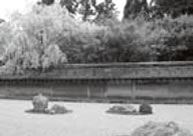 「寺社を歩けば京都がわかる」 より無料公開中!
「寺社を歩けば京都がわかる」 より無料公開中!
精選した京都の50余の寺社について、その歴史、建物の特徴、建立の由来などを日英対訳で紹介するガイドブック「寺社を歩けば京都がわかる」より、「龍安寺」「石清水八幡宮」「天龍寺」を無料公開中です。
The zen rock garden called the extreme of Zen consciousness
 Address: 13 Ryõan-ji Goryõnoshita-cho, Ukyõ-ku, Kyoto-shi
Address: 13 Ryõan-ji Goryõnoshita-cho, Ukyõ-ku, Kyoto-shi
Tel: 075 (463) 2216
Hours: 8:00AM–5:00PM
(December–February: 8:30AM–4:30PM)
Admission: ¥500
http://www.ryoanji.jp
7 min walk from Keifuku Kitano Railway Ryõanji Sta.
On the north side of Ryõan-ji a Zen temple of the Rinzai sect (Myõshin-ji school) stand the kuri and the hõjõ (the main hall). In front of the hõjõ is the famous sekitei (Zen rock garden). It is a rather small space, 25 meters east to west and 10 meters north to south, surrounded by an oiled dirt fence, containing fifteen stones, some standing vertically and others lying horizontally, some festooned with moss, others almost buried in the carefully patterned white sand that surrounds them. The rocks are simply arranged here and there, uninterrupted by tree or greenery. Some have said the stones are arranged to suggest a tiger carrying its cub on its back as it crosses a river, while others see an arrangement of numbers, and still others interpret the arrangement of the rocks as reflecting Buddhist teachings. In any case, they certainly reflect the artfulness of the Zen space.
How many Japanese people can give a simple answer to the question, “What is Zen?” Although it has been said that “The sekitei itself is the heart of Zen,” the average person is not likely to produce a clear explanation.
The person who taught us the true high level of the artistic expression of the rock garden was an American sculptor named Isamu Noguchi. This was after World War II, and the garden was not known worldwide as it is today.
The Muromachi Bakufu official Hosokawa Katsumoto, greatly impressed with the priest Giten Genshõ of the Myõshin-ji, gave him a villa that had formerly belonged to the Tokudaiji family. Giten was to establish the temple Ryõan-ji with this villa in 1450, with himself as head priest. But the temple he had worked so hard for was destroyed in the Õnin War, in which Katsumoto himself was killed in 1473. His son Masamoto rebuilt the temple with the priest Tokuhõ Zenketsu at its head, and the temple prospered; its compound grew to some twenty-one sub-temples. In 1797, however, almost all the buildings were destroyed in a fire.
Currently the primary buildings of Ryõan-ji are the hõjõ of the sub-temple Seigen-in, the kuri, and the kaizan-dõ, the last of which was erected in 1981.
Walking along the path through the trees on the west side of the temple grounds and on the promenade on the edge of Kyõyõchi pond, one can appreciate the spaciousness of the grounds. After pondering the small mystery of the rock garden, the landscape seems all the more refreshing.